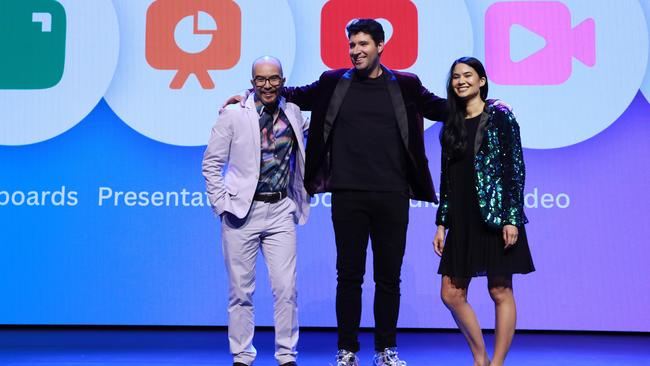Canva sexes up spreadsheet app, revenue soars to $3bn
Australia’s visual communications darling is intensifying its push into the lucrative enterprise market, unveiling a new spreadsheet app as part of its biggest product launch yet.

Australian visual communications darling Canva is intensifying its push into the lucrative enterprise market, launching a new spreadsheet app as part of its biggest product launch since its inception a decade ago.
The $US32bn company unveiled the new app at its annual showcase for customers at Los Angeles early on Friday morning (AEST).
The app works like a conventional spreadsheet, where users can input data and formulas. But it then takes that data to create executive-grade visual presentations via a few basic verbal prompts, thanks to artificial intelligence.
Co-founder Cliff Obrecht said the company’s foray into the enterprise market – selling subscriptions to Fortune 500 and Australia’s biggest companies – has catapulted Canva’s annualised revenue from $2.5bn, disclosed last October, to more than $3bn.
It comes as investors have been preparing for a much-hyped potential float, with Canva most likely to follow Atlassian’s lead with a US listing. But its founders have said repeatedly they are not in a rush, while market turmoil from Donald Trump’s trade war has smashed tech valuations.
“230 million people are now designing with Canva every month. This is what we are proud of,” Mr Obrecht said.
“Over 35 billion designs are being created on the platform, with over a billion created last month alone. So you can see that growth is just continuing to accelerate. That’s over 420 every second.
“We continue to power the modern workforce. Our bottom up adoption in these large organisations continues to be incredibly strong, and now that’s paired with some top down enterprise promotions as well.”

Its spreadsheet offering, Canva Sheets, is part of its new Visual Suite 2.0, which also includes a new coding tool that is designed for people with little tech knowledge to create different apps, again, thanks to AI.
Like other AI tools, Canva Code works via typing prompts in simple English. For example, Mr Obrecht created a tide chart for Sydney Harbour, which also included what fish species are best to target at certain tides.
In another example, he created a tool to help people beat jet lag when flying from Australia to America’s west coast.
Canva developed its AI in house and incorporated technology from one of its latest acquisitions, Leonardo.Ai, which has developed Australia’s homegrown AI model, dubbed Phoenix.
But Canva surprised its 5000 employees last week with its first known redundancy round, which affected its technical writing team. Technical writers distil complex information into easy-to-understand documentation such as software manuals and guides.
While AI has been performing more of these sorts of roles, Mr Obrecht said it had nothing to do with the redundancies and stresses he believed AI would amplify, not replace human creativity.
“It wasn’t actually AI that caused that. It was a change in workflows where we wanted engineers to be writing their own documentation, which makes a lot of sense, and it’s how the whole industry is evolving.
“So that wasn’t specifically to do with AI. In regards to the broader question around, will AI take jobs? I mean, it’s going to augment people’s jobs. Everyone has said this a million times: ‘it’s not AI that will replace humans, it’s humans with AI’.
“Really it’s about the modern workforce embracing this new toolkit, just like being someone doing accounts and not using the calculator when it came down from the mountain. It (AI) is just the latest tool, and it obviously increases efficiency massively.”

Other products in Visual Suite 2.0 include One Design, which Mr Obrecht said was a “world-first breakthrough that defines how teams create”.
“You’re probably thinking, ‘what the hell does that mean?’ We have a bunch of doc types. And currently, if you want to create a presentation, you need to go to the presentation doctype, use that. If you want to create a website, you have to go do that. If you want to go create a video, give your video doc type. You can’t connect all of them in the same design. What we’re launching is the ability to do that.
“So if you’re presenting to a team, you can actually have an in-line brainstorm, and then you can have absolutely anything in one design. My core examples are, when we’re doing a board deck, we start with an intro, we talk through a business update, then we might jump into the financials, so we may jump into a sheet, and then we may, sort of like work with the board to solicit ideas around a challenge we’re facing or an opportunity – so we’ll look down into a whiteboard.
“We’ll then summarise that whiteboard into a document with our AI summarisation tool, and then all of that lives in that one place.
“Other examples, you can have an entire marketing campaign in one document. You can have an entire sales strategy in one document.”







To join the conversation, please log in. Don't have an account? Register
Join the conversation, you are commenting as Logout